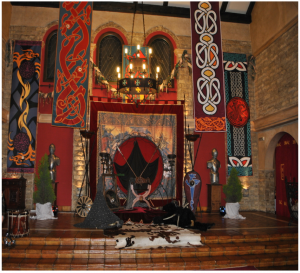Have you ever wondered what it would be like to walk through the medieval era? With stunning tapestries, rich wood, and ornate trinkets, this period offers a treasure trove of decoration ideas that can bring your home to life. As someone who has spent years exploring historical styles, I can assure you that the medieval aesthetic is not only unique but also incredibly inviting. In this article, we’ll dive deep into various medieval decoration ideas that can transform your living space into a castle of your own.
The Allure of Medieval Decor
Medieval decoration is more than just a style; it’s an experience. The rich colors, intricate designs, and warm materials evoke a sense of history and storytelling. Whether you aim for full-on medieval authenticity or simply wish to incorporate elements into a modern design, the following sections will guide you through various ideas, styles, and practical tips.
Why Choose a Medieval Theme?
There are many reasons to incorporate medieval decoration into your home:
- Timeless Aesthetic: The medieval style has a classic appeal that never goes out of fashion.
- Personal Connection: If you have an interest in history or literature, it’s a wonderful way to reflect your passions in your home.
- Unique Charm: Stand out from the crowd with a decor style that’s rich in character and history.
Key Elements of Medieval Decoration
To create an enchanting medieval atmosphere, you need to understand the key elements that define the style.
1. Color Palette
Medieval decor typically features rich, deep colors. Think burgundy, forest green, royal blue, and gold. These colors evoke the opulence of the era and can be used in walls, furniture, and accessories.

2. Furniture
Incorporate heavy, dark wood furniture. Look for pieces that have ornate carvings, such as:
- Chests
- Dining tables
- Benches
- Armoires
3. Fabrics and Textiles
Textiles play a crucial role in medieval decoration. Use rich fabrics like velvet, brocade, and tapestry. Consider:
- Wall tapestries depicting medieval scenes or landscapes
- Heavy drapes for windows
- Cushions in bold patterns

4. Lighting
Lighting fixtures should reflect the medieval style. Think wrought iron chandeliers and candle sconces to create a warm, inviting glow.
5. Accessories
Finally, accessorize with medieval-inspired items:
- Shield and sword wall decor
- Armor replicas
- Vintage books on medieval history

Medieval Decoration Styles
There are several styles within the medieval theme that can guide your design choices. Here are three popular ones:
1. Gothic Style
The Gothic style is characterized by pointed arches, ribbed vaults, and flying buttresses. To create a Gothic ambiance, focus on:
- Tall, narrow windows with stained glass
- Intricate woodwork
- Bold geometric patterns

2. Tudor Style
Tudor decor combines medieval and Renaissance styles with its half-timbered houses. Emphasize:
- Exposed beams
- Dark wood furnishings
- Textured wallpapers
3. Rustic Medieval
If you prefer a more relaxed, rustic approach, then this style is for you. Focus on:
- Natural wood finishes
- Earthenware and pottery
- Simple, cozy textiles

Practical Tips for Incorporating Medieval Decor
Start with a Focal Point
Choosing a central piece, such as a large tapestry or an ornate dining table, can establish the medieval theme and guide your additional decor choices.

Layer Textures
Blend different textures for added depth. For instance, mix soft fabrics with hard surfaces like stone or wood to create an inviting atmosphere.
Use Vintage Finds
Explore thrift stores, flea markets, and auctions for authentic medieval-inspired decor. Old books, candlesticks, and vintage textiles can add charm and history to your home.

Comparison Table: Key Elements of Various Medieval Styles
| Element | Gothic Style | Tudor Style | Rustic Medieval |
|---|---|---|---|
| Windows | Stained glass, tall and narrow | Half-timbered, leaded glass | Simple with wooden shutters |
| Furniture | Intricate, dark wood | Heavy, functional pieces | Rustic finishes, reclaimed wood |
| Textures | Bold, layered fabrics | Patterned textiles | Natural fibers, cozy textiles |
Pros and Cons of Medieval Decoration
Before diving into the medieval theme, consider the pros and cons.
Pros
- Unique Aesthetic: Medieval decor is unlike any other style.
- Rich History: Each piece can tell a story.
- A Timeless Appeal: The charm of the medieval era endures.
Cons
- Potential Clutter: Too many items can overwhelm a space.
- Cost: Authentic pieces can be expensive.
- Maintenance: Some materials require careful upkeep.
FAQs about Medieval Decoration
What colors are best for medieval decor?
Rich colors such as burgundy, deep greens, royal blues, and golds are preferred. They evoke the opulence of the medieval era.
How can I incorporate medieval decor in a modern home?
Mix modern furniture with medieval accessories such as tapestries, wall art, or vintage trinkets to achieve a balanced look.
What materials are commonly used in medieval decor?
Primary materials include dark woods, wrought iron, rich fabrics like velvet, tapestries, stone, and leather.
Can I create a medieval-themed room on a budget?
Yes! Look for second-hand items, DIY decor projects, and use deep, warm paint colors to evoke the medieval feel without breaking the bank.
Conclusion: Creating Your Own Medieval Retreat
Incorporating medieval decoration into your home is a rewarding venture that allows you to express your love for history and art. I hope these ideas inspire you to create a captivating medieval retreat that reflects your personality and style. Whether you opt for a bold Gothic aesthetic, a cozy Tudor ambience, or a rustic medieval feel, each choice will resonate warmth and timeless character. Happy decorating!